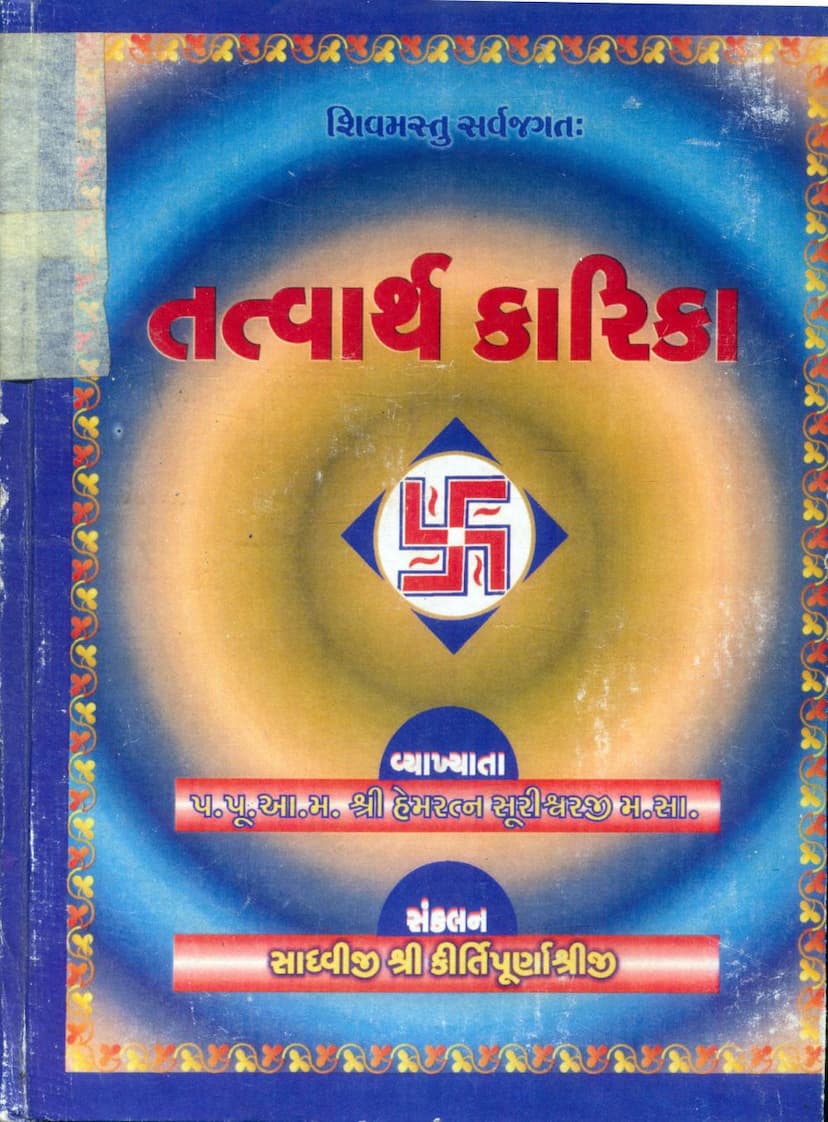Tattvartha Karika
Added to library: September 2, 2025

Summary
Certainly, here'i a comprehensive summary of the Jain text "Tattvartha Karika" by Kirtipurnashreeji, based on the provided pages:
The book "Tattvartha Karika" by Kirtipurnashreeji, with the blessings and inspiration of Acharya Shri Hemratnasurishwarji Maharaj, is a compilation of spiritual discourses (pravachans) that delve into various aspects of Jain philosophy and practice. The text aims to guide readers towards spiritual upliftment and liberation (moksha).
Core Themes and Structure:
The book is structured around a series of "Pravachans" (discourses) numbered from one to forty-one, covering a wide range of topics. It also includes sections on "Prashnottari" (Question and Answer), and specific discourses like "Diwali Vyakhyaan" and "Uttaradhyayan." The overarching theme is the pursuit of "Tattvartha" (the true meaning or essence) in Jainism, leading to the ultimate goal of moksha.
Key Concepts Discussed:
The discourses touch upon several fundamental Jain principles and practices, explained through stories, examples, and philosophical explanations:
- Mangala (Auspiciousness): The text begins by emphasizing the concept of "Mangala" as outlined in the initial verses, focusing on Lord Mahavir, Lord Gautam, Sthulibhadra, and the Jain Dharma itself as sources of auspiciousness. It explores why these specific figures and the Dharma are considered auspicious, highlighting their overcoming of challenges and their spiritual achievements.
- The Nature of Happiness and Suffering: The discourses repeatedly address the transient nature of worldly pleasures and the root causes of suffering, which are identified as desires, attachments, and the cycle of birth and death (samsara). True happiness is presented as being found in spiritual detachment and self-realization.
- The Importance of Right Knowledge, Right Faith, and Right Conduct (Ratna-trayi): The text emphasizes that true liberation (moksha) is achieved through the perfect combination of Samyak Darshan (Right Faith), Samyak Gyan (Right Knowledge), and Samyak Charitra (Right Conduct). These are presented as the 'medicine' for the 'disease' of birth.
- Karma and its Consequences: A significant portion of the discourses deals with the intricate workings of karma, explaining how actions (karma) lead to specific results (phala) and influence one's destiny across lifetimes. The concept of "Anubandha" (the continuing impact of actions) is explored, highlighting how even small actions can have significant long-term consequences.
- The Meaning of Mangala: Beyond superficial auspiciousness, the text delves into the deeper meaning of mangala, linking it to the purification of one's karma, the attainment of inner purity, and the development of positive spiritual qualities.
- Control of the Senses and Mind: The discourses stress the importance of controlling the five senses and the mind, which are identified as the primary gateways to spiritual downfall if left unchecked. Overcoming desires (vasana) and passions (kashaya) is a recurring theme.
- The Role of Asceticism and Austerity (Tapa): Various forms of tapas are discussed as essential tools for purifying the soul and burning off accumulated karma. The sacrifices and hardships undertaken by ascetics are presented as a path to spiritual advancement.
- The Significance of Jain Rituals and Practices: Practices like Samayika (equanimity), Pratikramana (repentance), and Puja (worship) are explained in terms of their spiritual benefits and how they contribute to purifying the soul and strengthening one's connection to the Dharma.
- The Importance of Renunciation and Detachment: The text highlights the virtue of renouncing worldly possessions, attachments, and sensory pleasures as a crucial step towards liberation. The example of ascetics who live simply and detach themselves from worldly comforts is often cited.
- The Teachings of the Tirthankaras: The discourses frequently refer to the lives and teachings of the Tirthankaras, particularly Lord Mahavir, as examples of spiritual perfection and guidance. Their lives are presented as a roadmap for achieving the highest spiritual state.
- The Nature of Happiness: True happiness is not found in external possessions or sensory gratifications but in inner peace, contentment, and the realization of the soul's true nature. The discourses contrast the fleeting pleasures of the world with the eternal bliss of liberation.
- The Importance of Good Conduct and Intent: Beyond mere outward actions, the text emphasizes the significance of inner intentions (bhava) and the purity of one's mind. Good conduct, even in small acts, performed with the right intention, can lead to significant spiritual merit.
- The Role of the Guru: The importance of a spiritual guide (Guru) is acknowledged as essential for navigating the complexities of spiritual practice and understanding the true meaning of scriptures.
- The Power of Devotion and Remembrance: The discourses highlight the immense power of devotion (bhakti) and the constant remembrance of the divine (smaran) in overcoming obstacles and purifying the soul.
- The Four Pillars of Jainism: The text reiterates the importance of Daan (Charity), Sheel (Virtue), Tap (Austerity), and Bhav (Right Intention) as the foundational pillars of Jain practice.
- Ahimsa (Non-violence): While not explicitly a separate chapter, the principle of ahimsa is subtly woven throughout the discussions on diet, conduct, and compassion towards all living beings. The emphasis on purity in food and avoiding harm to even the smallest creatures underscores this core tenet.
- The Goal of Moksha: The ultimate aim of all these practices and principles is to break free from the cycle of birth and death and attain moksha, the state of eternal bliss and liberation.
Overall Message:
"Tattvartha Karika" serves as a comprehensive spiritual guide, offering practical advice and philosophical insights for followers of Jainism. It encourages self-reflection, disciplined living, and a steadfast devotion to the path of liberation as laid out by the Tirthankaras and spiritual leaders. The discourses aim to foster a deeper understanding and appreciation of Jain principles, motivating readers to transform their lives and progress towards their ultimate spiritual goal.